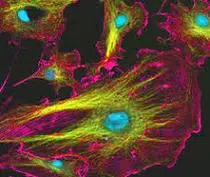In order to fully understand the meaning of the term cytoskeleton, it is necessary, first of all, to discover its etymological origin. In this case, we can state that it is a word that derives from Greek because it is the result of the following Greek components:
-The noun “cyto”, which is synonymous with “cell”.
-The word “skeletos”, which refers to the “skeleton”, that is, the set of bones in the body of vertebrates that protect the internal organs.
The cytoskeleton is a system composed of proteins found in cells that enables cell movement. This framework also contributes to the organization of the cell's structures, which provides support so that it retains its shape.
 Many of the cell 's functions, in fact, are developed thanks to the presence of the cytoskeleton. In addition to mobility, it also allows, for example, cell division .
Many of the cell 's functions, in fact, are developed thanks to the presence of the cytoskeleton. In addition to mobility, it also allows, for example, cell division .
Among the cytoskeletal components of eukaryotic cells we find microtubules , intermediate filaments and microfilaments . Microtubules , which develop in the extension of the cytoplasm , arise through the polymerization of the beta and alpha tubulin proteins.
Regarding microtubules we can highlight another series of aspects of interest such as the following:
-They are tube-shaped and have a size between 20 to 25 millimeters in diameter.
-They play a fundamental role in getting vesicles and organelles to move.
-They come to grow from the centrosome to the periphery of the cell in question.
-What is the external movement of the cell is achieved through the flagella and cilia.
The intermediate filaments of the cytoskeleton are considered the most stable elements in the cytoskeleton. Desmin, vimentin and cytokeratin are some of the proteins that make it up. As for microfilaments , they have a pair of actin chains that are linked in a helix.
In the same way, we cannot ignore another series of proteins that make up the intermediate filaments. We are referring to some such as nestin, nuclear lamins or glial fibrillary acidic protein, which is also known by the name GFAP.
In addition to these filaments, we can highlight the fact that they have about 10 millimeters in diameter and that they are responsible for providing tensile strength to the cell.
Regarding the cytoskeleton of prokaryotic cells , it was initially thought that it did not exist. However, over time , structures similar to those present in the cytoskeleton in eukaryotic cells were detected.
The so-called cytoskeleton of prokaryotes, therefore, is formed by the various structural filaments of this type of cell. As in eukaryotes, the cytoskeleton is involved in functions such as maintaining cell shape and division. Crescentin, MreB and FtsZ are the components of the cytoskeleton in the cells of prokaryotic organisms.
